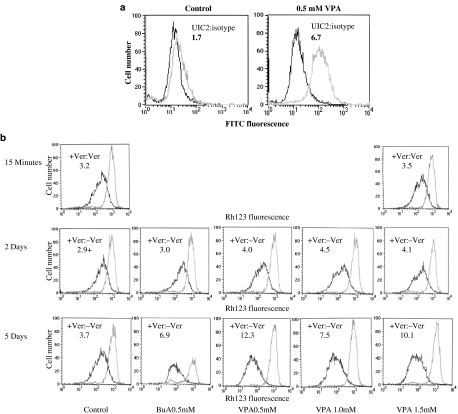Figure 2.
Effect of valproic acid on P-gp function in SW620 and KG1a cells. The abscissa is a logarithmic scale of fluorescence intensity. The ordinate shows the relative frequency of cells in a given fluorescence intensity channel. (a) Indirect immunofluorescence staining of P-gp in SW620 cells. Cells incubated for 5 days with medium containing valproic acid or the vehicle only were washed and incubated with UIC2 anti-P-gp antibody (bright line) or the isotype control (dark line). The ratio of mean fluorescence intensities in the absence and in the presence of the primary antibody is presented for each treatment. (b) Rh123 efflux from KG1a cells treated with butyric acid (BuA, 0.5 mM) or valproic acid (VPA, 0.5–1.5 mM). Cells were treated with the test compounds for the indicated periods, washed with PBS and incubated with Rh123 with or without verapamil (Ver), then washed again and Rh123 efflux established, in the absence (dark line) or presence (bright line) of verapamil. The ratio of Rh123 fluorescence retained in the cells in the absence of verapamil to that obtained in the presence of verapamil is presented for each treatment as a numerical value within each histogram. Higher values indicate increased P-gp expression or function, for Figure 2a and b, respectively. Similar results were obtained in two additional experiments.

